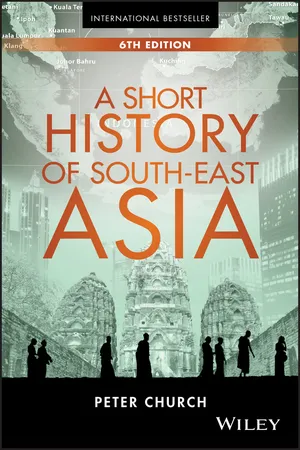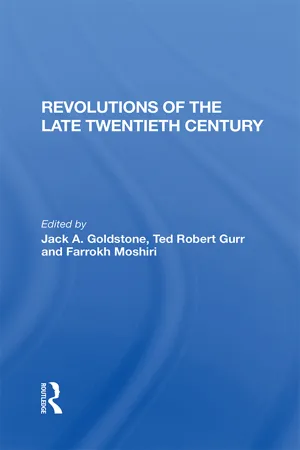History
Khmer Empire
The Khmer Empire was a powerful state in Southeast Asia from the 9th to the 15th century. Centered in present-day Cambodia, it was known for its impressive architecture, including the famous temple complex of Angkor Wat. The empire also had a sophisticated system of governance and was influential in the region's art, culture, and religion.
Written by Perlego with AI-assistance
Related key terms
3 Key excerpts on "Khmer Empire"
- eBook - ePub
- Peter Church(Author)
- 2017(Publication Date)
- Wiley(Publisher)
By then, however, the principal religious focus of Khmer society had altered. Varieties of Buddhism had long coexisted with the Hindu Devaraj cults but, during the 13th century, Theravada Buddhism won general allegiance. This form of Buddhism, originally defined in Sri Lanka and possibly Burma, was organised by its sangha (order of monks) and clear about what constituted Buddhist orthodoxy, while also being able to subsume Hindu and animist elements. It was rapidly becoming the dominant religion in mainland South‐East Asia. The concept of Devaraj, celebrated by Brahmanic officiants, would persist in Khmer society, but a godly king would now demonstrate his virtue primarily through patronage of Theravada Buddhist temples, monasteries, and schools. As a consequence, perhaps, interest in the temple‐mausoleums of former rulers declined.In the 1440s, the Khmer ruling class abandoned the Angkor region. Besides the impact of Theravada Buddhism there are other possible reasons for this shift. Court factionalism may have weakened the firm government needed for such an intricately connected “hydraulic society” to work, and hastened ecological deterioration of a region which had been intensively exploited for centuries. The general population of the area may have drifted away as the irrigation system silted up. Malaria has also been suggested as a factor in Angkor's abandonment. The best established factor in the transfer of the kingdom is the rise, from 1351, of the ambitious Thai state of Ayudhya. The Thais insistently attacked Angkor, looting it of wealth and people. A Khmer capital to the south‐east (variously in later centuries Phnom Penh, Udong, and Lovek) may have seemed more defensible than Angkor. Such cities were also nearer the sea and the booming maritime trade of 15th‐century South‐East Asia.THE KINGDOM OF CAMBODIA, 15TH–18TH CENTURIES
Until late in the 16th century the translated Khmer kingdom appears to have been quite strong, an equal of neighbours like Ayudhya, Lan Xang (Laos), and Vietnam. Intermittent warfare with the Thais continued, but also peaceful trade and cultural exchange. In religion, polity, and culture, the Thai and Khmer kingdoms had much in common. In 1593, however, the Thai king Narasuen attacked Cambodia as part of his strategy to reaffirm the power of Ayudhya after a devastating assault on his city by the Burmese. From this time, Cambodia slipped decisively—at least in Thai eyes—to the status of a Thai vassal state. - eBook - ePub
- Jack Goldstone, Ted Robert Gurr, Farrokh Moshiri(Authors)
- 2019(Publication Date)
- Routledge(Publisher)
10 Cambodia: Revolution, Genocide, Intervention BARBARA HARFFIn 1975, the Communist Khmer Rouge achieved victory in its revolutionary war against the U.S.-supported government of Lon Nol. Declaring a new state—the Democratic Republic of Kampuchea—the Khmer Rouge sought to totally restructure Cambodian society by eliminating all "modern" elements. The brutality of its efforts, and the Khmer Rouges own aggression against Vietnam, led to Vietnam's intervention and occupation of Cambodia. The genocidal policies of the Khmer Rouge were unprecedented in Southeast Asia. However, their revolution, and Vietnam's invasion, were rooted in a long Cambodian history of foreign intervention and struggles for independence.The history of the Cambodian people—the Khmers—goes back to the ancient kingdom of Funan (first-sixth centuries A.D. ), which occupied the area that is now Cambodia, southern Laos, Malaya, South Vietnam, and parts of Thailand. It was an Indianized state, but the people were of Indonesian and Chinese stock. The name Cambodia derives from the Hindu word Kambuju, for Kambu—a figure in Cambodian mythology. The famous Khmer kingdom known as the Angkor Empire, which took shape in the ninth century, was the successor of the Funan kingdom. During its brilliant but relatively short duration, arts and architecture flourished, and Angkor's kings built dikes and canals so that agricultural productivity increased. During this period the magnificent Angkor Wat temple complex was built, and for todays Cambodians, it is a symbol of pride in their ancient culture. From the fifteenth century onward, the Cambodians were attacked by neighboring Siam (present-day Thailand) and Vietnam and eventually yielded large parts of their territory to Siam.In 1863, the French rescued Cambodia from total annihilation by the Siamese and Vietnamese by declaring it a French protectorate. During World War II, the Vichy French first administered Cambodia and then were replaced by the Japanese, - eBook - ePub
- (Author)
- 2018(Publication Date)
- Lonely Planet(Publisher)
Angkor was losing control over the peripheries of its empire. At the same time, the Thais were ascendant, having migrated south from Yunnan, China, to escape Kublai Khan and his Mongol hordes. The Thais, first from Sukothai, later Ayuthaya, grew in strength and made repeated incursions into Angkor before finally sacking the city in 1431 and making off with thousands of intellectuals, artisans and dancers from the royal court. During this period, perhaps drawn by the opportunities for sea trade with China and fearful of the increasingly bellicose Thais, the Khmer elite began to migrate to the Phnom Penh area. The capital shifted several times over the centuries but eventually settled in present-day Phnom Penh.From 1500 until the arrival of the French in 1863, Cambodia was ruled by a series of weak kings beset by dynastic rivalries. In the face of such intrigue, they sought the protection – granted, of course, at a price – of either Thailand or Vietnam. In the 17th century, the Nguyen lords of southern Vietnam came to the rescue of the Cambodian king in return for settlement rights in the Mekong Delta region. The Khmers still refer to this region as Kampuchea Krom (Lower Cambodia), even though it is well and truly populated by the Vietnamese today.In the west, the Thais controlled the provinces of Battambang and Siem Reap from 1794 and held influence over the Cambodian royal family. Indeed, one king was crowned in Bangkok and placed on the throne at Udong with the help of the Thai army. That Cambodia survived through the 18th century as a distinct entity is due to the preoccupations of its neighbours: while the Thais were expending their energy and resources fighting the Burmese, the Vietnamese were wholly absorbed by internal strife. The pattern continued for more than two centuries, the carcass of Cambodia pulled back and forth between two powerful tigers.The French in Cambodia
The era of yo-yoing between Thai and Vietnamese masters came to a close in 1863, when French gunboats intimidated King Norodom I (r 1860–1904) into signing a treaty of protectorate. Ironically, it really was a protectorate, as Cambodia was in danger of going the way of Champa and vanishing from the map. French control of Cambodia developed as a sideshow to its interests in Vietnam, uncannily similar to the American experience a century later, and initially involved little direct interference in Cambodia’s affairs. The French presence also helped keep Norodom on the throne despite the ambitions of his rebellious half-brothers.
Learn about this page
Index pages curate the most relevant extracts from our library of academic textbooks. They’ve been created using an in-house natural language model (NLM), each adding context and meaning to key research topics.


